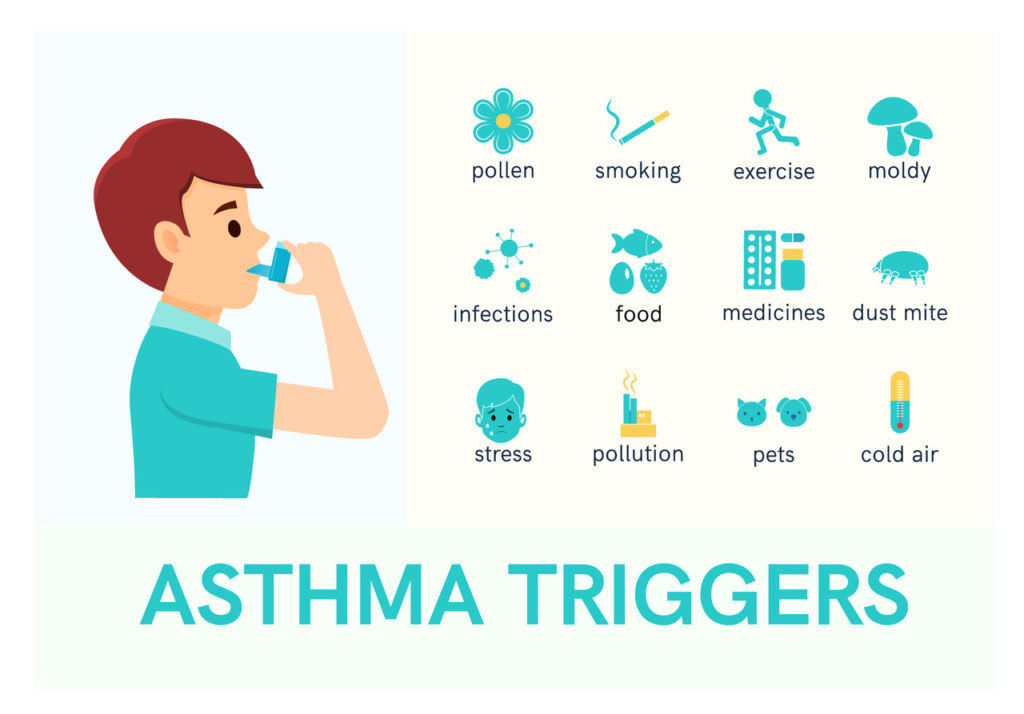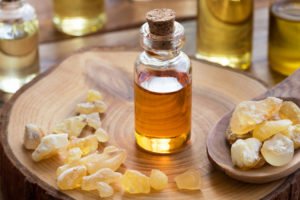What's On This Page?
ToggleIf you’ve ever had your bronchial tube go into a spasm, you know how scary it is! Bronchospasm occurs when the breathing airways suddenly contract, making it hard to breathe and causing that high-pitched, whistling sound called wheezing. The cause of bronchospasm isn’t always clear to a person. It could be related to many things including chronic inflammation, inhaled compounds, or a sudden allergic reaction. If this goes on chronically, it is termed bronchial asthma or just asthma.
About 25 million Americans have asthma which is approximately one person out of every 13. Asthma attacks may be mild and short-lived, and the acute episode is over in minutes, then you can breathe well again. But in serious cases, an attack can be very severe, and the episode may go on for a long time, and maybe even fatal. On average, 10 Americans pass away from asthma every single day. During the year 2019, over 3,500 people died from asthma and some of these deaths could have been avoided with adequate medication, treatment, and care.
Bronchospasm is something that requires professional medical treatment and supervision. Today’s article is for those of you who wish to breathe easier and are seeking natural options to use adjunctively with your medication. If you see something below that you’d like to try, please ask your doctor(s) if it’s right for you.
I have another article on this topic that you will love, Breathe Easy: Understanding Prescribed Asthma Medications.
Symptoms of Asthma
Symptoms vary from day to day, sometimes hour to hour in a person who suffers from bronchial spasms or asthma. One thing that is most common is the sensation of suffocation because it’s difficult to take a full breath or catch your breath. Here are other signs and symptoms:
- Wheezing
- Coughing
- Shortness of breath – read my article, Revealing 15 Hidden Causes Of Shortness Of Breath And How To Overcome Them
- Exercise intolerance
- Chest pain
- Chest pressure or tightness
- Daytime fatigue
- Night waking (with nocturnal asthma)
- Sinus infections
- Allergies
- Acid reflux (or “GERD”)
4 Causes of Wheezing, Bronchospasm, and Asthma
Respiratory distress isn’t always the chronic condition called “asthma.” There are so many reasons for a person to have a problem breathing, so I’d like to share a few of the lesser-known causes since the main causes are all over the Internet. Here are 4 lesser-known triggers for breathing problems:
1. You have a chronic unknown allergic reaction to perfume or shaving cologne.
Strong scents are a common but overlooked trigger for asthma attacks. In fact, there are many people who cannot stand the smell of perfumes but don’t realize it’s causing their breathing difficulties. For some asthma sufferers, the cologne or perfume (which often contains hundreds of synthetic chemicals) is the sole reason of a serious attack. Perfume is a common “migrenade” for people with migraines too. Read more on the topic of migraines and headaches in my book, Headache Free: Relieve Migraine, Tension, Cluster, Menstrual and Lyme Headaches.

2. You are allergic to your pet’s fur.
Do you have a cat or a dog? This is one overlooked (but common) trigger for chronic asthma symptoms. Everyone always talks about their sensitivity to pollen and dust mites, which may very well be, but pet fur is a big one.
Here’s one RESOURCE about allergic asthma being caused by cats. The reason isn’t the fur like you may suspect, it’s the saliva that contains a highly allergenic protein abbreviated as “Fel d 1” which triggers IgE release in humans.
There’s no real easy way to reduce Fel d 1 in your cat’s saliva, but I did find this amusing article about it. You can CLICK HERE to read it.
3. It’s coming from your heart.
This is called “Cardiogenic Asthma” or “Cardiac Asthma” and in this case, the wheezing and fluid in the lungs (termed “pulmonary edema”) is caused by an inefficient heart, usually on the left side. When the heart is not pumping normally, it may be termed “heart failure” and it causes some fluid to collect in the lungs or in/around your breathing airways. The fluid build-up is what causes wheezing, rales, and breathlessness.
True asthma isn’t associated with heart failure, only cardiogenic asthma. This distinction is important for you to know because the treatment protocol varies. Rescue inhalers will often work, as well corticosteroid inhalers, however, those are not considered the mainstays of treatment. IMPORTANT – you should not overuse those rescue inhalers for this type of condition, but rather seek proper medical attention from a cardiologist or lung specialist that understands the differences between these conditions.
Your goal is to improve the function and efficiency of your heart, more so than the lungs. Here’s a STUDY where you can learn more.
4. Your Home or Office May have Cockroaches.
Here’s another lesser-known cause for wheezing, bronchospasm, and asthma symptoms. There is an enzyme (a protein) found in the excrement and the saliva of these bugs that trigger asthma. When I lived down south, it was the headache of every Florida resident! There’s no chance that you can live in Florida and not ever see one! I’m not picking on Florida, there’s an estimate that over 60 percent of homes in the U.S. contain cockroach allergens. Statistics show cockroach allergies are one of the most common worldwide indoor allergies. Combine that with a pet cat or dog and you have the makings for some difficult breathing! (Read below for some remedies and treatments.)
Anyway, a cockroach’s saliva, feces, and ‘shedding’ body parts are all kicked up in the air at one point or another, and after you inhale it, it could trigger symptoms that are uncomfortable, including asthma-related symptoms, and chronic allergies! You can READ THIS to learn more and see how the symptoms look almost identical to asthma.
At this point, I would like to plead for your forgiveness because this next ARTICLE is going to make you sick to your stomach. Do not read it if you like crab and shrimp. The protein called “tropomyosin” could be the cross-reactive allergen between mites, cockroaches, shrimp and crab. All of those foods as well as cockroaches contain tropomyosin. (Sorry!) You can evaluate your sensitivity to that protein with a blood test to see if you’re allergic or not, then you’ll know whether or not to stay away from those foods.
Herbal Remedies and Devices that Ease Breathing
One reason there is no asthma cure is that attacks are caused by our own immune systems. The immune system is a very complex and shape-shifting system in our body. It’s more reactive at certain times of the year, and there may even be a circadian rhythm component to how reactive we are. Most medical research shows that the worst breathing difficulties are more apt to occur about four to six hours after you fall asleep.
Right now, I’d like to focus on some remedies that you can buy, and hopefully, they will help you. Since asthma is such a serious condition, and many of you already take medications, you must ask your practitioner(s) if these are right for you:
Primatene Mist.
This is the only over-the-counter (OTC) inhaler approved by the FDA for the temporary relief of mild asthma symptoms. This means it can help with mild, occasional, or intermittent symptoms such as wheezing, tightness of the chest and breathlessness. Once again, this product has epinephrine in it as the active ingredient (Saying this because years ago they took it out).

Vitamin D-rich foods.
Eating more foods with vitamin D such as milk and eggs can help. Getting the sunshine vitamin is useful too, because your body activates the D into a hormone that is used for immune function.*
Black Seed Oil.
This is a dietary supplement that fights inflammation and is especially useful for the lungs. It contains many active compounds such as “thymoquinone” which has been studied for its effect on excessive inflammation and cytokine storms.
A journal ARTICLE published in May 2021 entitled, A Promising Natural Compound with Potential Benefits for COVID-19 Prevention and Cure, just discussed the benefits of thymoquinone or TQ as they call it. They found that it has strong anti-inflammatory potential as well as immunomodulatory activities. Read the science yourself, it will take you just a few minutes to see how beneficial TQ can be for the lungs.
Fenugreek Seed.
In 2018, there was a STUDY done that served to determine the effectiveness of fenugreek seeds (Tregonella foenum graceum) in people with mild asthma. I want to note that this supplement is most often used several days after giving birth by women who need to increase their milk supply. It has widespread hormonal effects, so again, ask your doctor about anything you read today before self-treating.
The Breather
The Breather: Natural Breathing Lung Recovery Exercise Trainer.
This is a small plastic device that you hold in your hand and breathe with. I really like this because it works fast, and it’s not a drug. It’s designed to improve the flow of oxygen. It’s just an exerciser, it’s not intended or useful during an asthma attack. The Breather has an adjustable dial that you can set depending on the amount of resistance you want for inhalation and exhalation.
I bought one of these to examine and it’s really impressive. It can be used for people suffering from difficulty swallowing (dysphagia) and those with Heart Failure, as well as other conditions. You can watch a video on THIS PAGE. With continued usage, it may be able to help with dyspnea, peak cough flow, voice box function, speech and swallowing performance as well as the overall quality of life. Musicians, swimmers (divers), and pilots might like this.
AirPhysio – Natural Breathing Lung Expansion & Mucus Removal Device.
This is another small plastic device that you hold in your hand and breathe with. It is helpful to clear the airways and minimize mucus which can be helpful with many respiratory conditions such as asthma, atelectasis, COPD, Emphysema, and even Cystic Fibrosis. With continued use, this Australian-made device may help loosen the bond of mucus to the airway walls.
The intention is to get that phlegm up! It works well, very quickly and most people need a few minutes to find relief. With continued use (once or twice daily) it can assist breathing and improve lung capacity. Scuba divers, musicians, and athletes might like this one or the unit above! You can watch a VIDEO about AirPhysio by CLICKING HERE.
BreatheEasy Lung Exerciser and Expander
This device provides similar benefits to the ones I’ve mentioned above, but the unit looks different. You can use this several times a week and use it for exhalation and/or inhalation training.

Essential Oils.
If you don’t have a stockpile of the proper breathing essential oils, consider buying some. Inhaling the right oils, like doTERRA Breathe, can make a world of difference for some people, and there are similar products with good essential oils that help open up airways.
Put a few drops of your favorite essential oils into an aromatizer to enjoy in your home/office.
MOXE Breathe.
You can also buy this Himalayan sea salt “nasal inhaler” that is infused with essential oils of peppermint, eucalyptus, cajeput, lavender, rosemary, and tea tree oil. It’s designed to instantly help you with a stuffy nose and breathing issues. It won’t help with anything serious like bronchospasm, it’s just a nifty little sea salt-based inhaler that you can put in your pocket. It might help with alertness, brain power, and focus as well as headaches due to the special essential oils.
I hope this article has helped you. Feel free to forward it to a loved one who needs help. If you have any products or treatments that you can suggest to others, I’m happy to post a few of your comments here. Just email me with your suggestion or remedy at scriptessentials@gmail.com.
Please seek medical attention and proper treatment if you have breathing difficulties. The options above are for your consideration and are not intended to treat an asthma attack.
For more info visit Sunshine Helps With Asthma

Suzy Cohen, has been a licensed pharmacist for over 30 years and believes the best approach to chronic illness is a combination of natural medicine and conventional. She founded her own dietary supplement company specializing in custom-formulas, some of which have patents. With a special focus on functional medicine, thyroid health and drug nutrient depletion, Suzy is the author of several related books including Thyroid Healthy, Drug Muggers, Diabetes Without Drugs, and a nationally syndicated column.



